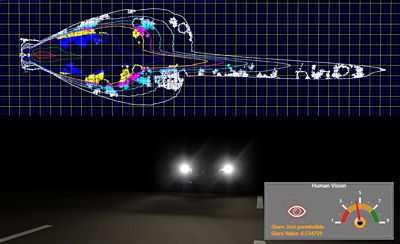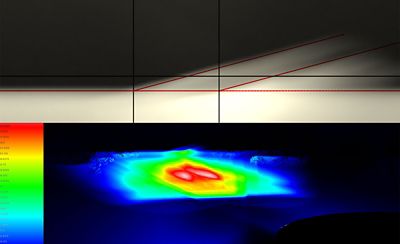-
-
Kostenlose Software für Studierende
Ansys unterstützt die nächste Generation von Ingenieur*innen
Studenten erhalten kostenlosen Zugang zu erstklassiger Simulationssoftware.
-
Verbinden Sie sich jetzt mit Ansys!
Gestalten Sie Ihre Zukunft
Stellen Sie eine Verbindung mit Ansys her, um zu erfahren, wie Simulation Ihren nächsten Durchbruch vorantreiben kann.
Länder und Regionen
Kostenlose Demoversionen
Produkte & Dienstleistungen
Lernportal
Über das Unternehmen
Back
Produkte & Dienstleistungen
Back
Lernportal
Ansys unterstützt die nächste Generation von Ingenieur*innen
Studenten erhalten kostenlosen Zugang zu erstklassiger Simulationssoftware.
Back
Über das Unternehmen
Gestalten Sie Ihre Zukunft
Stellen Sie eine Verbindung mit Ansys her, um zu erfahren, wie Simulation Ihren nächsten Durchbruch vorantreiben kann.
Kostenlose Demoversionen
THEMENDETAILS
Was sind adaptive Scheinwerfer?
Adaptive Scheinwerfer nutzen ein Zusammenspiel verschiedener Technologien, um Ausrichtung, Entfernung, Helligkeit und Lichtmuster der Scheinwerfer zu steuern und so für eine bessere Ausleuchtung bei Nacht zu sorgen und gleichzeitig die Blendwirkung für andere Verkehrsteilnehmer zu minimieren.
Die beiden gängigen Typen adaptiver Scheinwerfersysteme sind adaptive Fahrlichtsysteme (Adaptive Driving Beam, ADB) und adaptive Kurvenlichtsysteme (Adaptive Front Lighting System, AFS). Adaptive Scheinwerfer nutzen Kameras, Radar, Lidar und Lichtsensoren sowie Wetter- und Geschwindigkeits- und Lenkdaten, um sich aktiv an veränderliche Situationen anzupassen.
Die meisten Funktionen adaptiver Scheinwerfersysteme können einer der folgenden drei Scheinwerfertechnologien zugeordnet werden:
- Automatisches Fernlicht: Einschalten des Fernlichts, wenn sich keine Autos vor dem Fahrzeug befinden, und Zurückschalten auf Abblendlicht, wenn andere Fahrzeuge erfasst werden
- Kurvenadaptive Scheinwerfer: Ein AFS-System, das in einer Kurve einen oder beide Scheinwerfer so ausrichtet, dass die fahrzeugführende Person den Straßenverlauf besser sehen kann
- Adaptives Fernlicht (ADB): Passt die Helligkeit verschiedener Teile des Fernlichts an, sodass in freien Bereichen mehr und in befahrenen Bereichen weniger Licht abgegeben wird
Die meisten neuen Fahrzeuge verfügen über ein adaptives Fernlicht oder Systeme, bei denen die Scheinwerfer in Kurven gedreht werden. In Europa sind adaptive Fahrscheinwerfer mit Lichtmuster erhältlich. Die neu eingeführten Normen der US-Bundesbehörde für Straßen- und Fahrzeugsicherheit (National Highway and Traffic Safety Administration, NHTSA) haben bei Automobilherstellern und -zulieferern auf dem US-amerikanischen Markt einen Wettlauf ausgelöst, Produkte zu entwickeln, die den neuen Normen entsprechen. Insbesondere der Standard FMVSS 108 definiert den Einsatz von Simulationen für die virtuelle ADB-Zertifizierung.
Die Vorteile adaptiver Scheinwerfer
Eine Fülle von Daten zeigt, dass Fahrzeugunfälle mit anderen Fahrzeugen und Passanten nachts häufiger auftreten. 76 % aller tödlichen Unfälle mit Fußgängern treten nachts auf. Bei 12-15 % aller Verkehrsunfälle wird die Blendwirkung von Scheinwerfern entgegenkommender Fahrzeuge als mitursächlich genannt. Neuere Systeme, die den fahrzeugführenden Personen eine bessere Sicht auf die Straße und den weiteren Straßenverlauf ermöglichen, wirken sich positiv aus und verringern die Zahl der Unfälle zwischen Fahrzeugen und Fußgängern um bis zu 23 %.
Diese Zahlen haben Automobilhersteller wie Tesla, Audi, BMW, Ford, Honda, Mercedes-Benz, Porsche und Toyota dazu veranlasst, neue adaptive Lichttechnologien zu erforschen. Derzeit ist diese Technologie nicht vorgeschrieben. Dennoch sieht die Automobilbranche verschiedene Varianten adaptiver Scheinwerfer als eine Möglichkeit, Verbrauchern zusätzliche Sicherheitsfunktionen zu bieten und ihre neuen Fahrzeuge auf einem hart umkämpften Markt abzugrenzen.
Wie funktionieren adaptive Scheinwerfer?
Scheinwerfer bestehen nicht mehr nur aus einer einzelnen Abblend- und einer einzelnen Fernlichtbirne in einem Reflektor, die manuell ein- oder ausgeschaltet werden. Scheinwerfer sind jetzt moderne Systeme mit Software, komplexen Baugruppen und Schnittstellen zum Fahrzeugnetzwerk.
Jeder Hersteller hat seine eigene Konfiguration und Systembezeichnung für automatisches Fernlicht, Kurvenlicht und Lichtmuster, aber die meisten Komponenten können in die folgenden Kategorien eingeteilt werden.
Sensoren
Eine Vielzahl von Sensoren erfasst Informationen, darunter Abbiegen, Fahrzeuggeschwindigkeit, Lichtverhältnisse, Wetter, Fahrbahnverhältnisse, Fahrbahnbreite sowie die Positionen anderer Fahrzeuge. Fahrzeuge neuerer Baujahre nutzen jetzt auch GPS- und Kartendaten, um das System proaktiv zu informieren. Sensoren können so komplex sein wie optische oder Wärme-/Infrarotkameras, aber auch Radar-, Lidar-oder Sonar-Entfernungsmessgeräte, die bereits in Fahrzeuge zur Unterstützung anderer Sicherheitssysteme integriert wurden. Diese Geräte melden Größe, Position und Geschwindigkeit von Objekten, insbesondere entgegenkommenden Autos. Einfachere Sensoren melden die Position des Lenkrads, Umgebungslichtbedingungen und Wetterinformationen. Die genaue Leistung von ADB-Systemen erfordert eine präzise Rückkopplungsschleife zwischen Sensoren und dem ECU, um die nötigen Aktionen zu bewerkstelligen.
Software und Elektronik
Die Informationen der Sensoren werden an die Hardware der adaptiven Scheinwerfersteuerung übermittelt, damit sich die Steuerungssoftware des Systems an die aktuelle Situation anpassen kann. Die Elektronik kann in die Scheinwerferbaugruppe, ein separates Steuergerät oder den Fahrzeugkontrollcomputer integriert werden. Neben der Steuerung sind Software und Elektronik auch für die Stromversorgung der Scheinwerferbaugruppe mit der richtigen Spannung, Pulsweitenmodulation (PWM) und Qualität zuständig.
Scheinwerfer-Baugruppe
Wichtigstes Bestanteil eines adaptiven Scheinwerfersystems ist die Scheinwerferbaugruppe selbst. Das Steuersystem bestimmt den Schwenkbereich der Scheinwerfer, die Helligkeit der einzelnen Lichtquellen sowie die Hell- und Dunkelzonen des adaptiven Fernlichts. Am wichtigsten ist, dass die Scheinwerferbaugruppe den optischen Lichtpfad enthält. Ingenieur*innen verwenden umfangreiche Simulationen und Prototypen, um die optischen Eigenschaften der Baugruppe zu optimieren.
Im Folgenden finden Sie eine Beschreibung der einzelnen Unterkomponenten der Scheinwerfer-Baugruppe:
Gehäuse
Die Scheinwerferbaugruppe ist in einem gegenüber der Umgebung abgedichteten Gehäusemodul untergebracht, das in die Fahrzeugfront integriert ist und als Einheit ausgetauscht werden kann.
Linsen und Reflektoren
Form und Qualität des Strahls jeder Lichtquelle werden durch optische Linsen auf der Vorderseite der Gehäusebaugruppe, oder durch Reflektoren hinter der Lichtquelle gebildet. Einige Reflektoren sind adaptiv und können gemäß den Anweisungen des adaptiven Systems eingestellt oder geneigt werden.
Aktoren
Viele adaptive Scheinwerfersysteme ändern den Scheinwerferstrahl mithilfe von Schrittmotoren oder Aktoren, die Komponenten im Strahlengang bewegen oder die Ausrichtung der gesamten Baugruppe steuern. Aktoren in den Scheinwerferbaugruppen müssen robust genug sein, um Stößen und Vibrationen des Fahrzeugs, extremen Witterungsbedingungen und möglicherweise täglichem Einsatz über längere Zeit hinweg standzuhalten.
Lichtquelle
Die Lichtquelle ist das Herzstück jedes adaptiven Scheinwerfersystems. Sie kann aus einer oder mehreren Halogenbirnen, Xenon-Projektorlampen, LED-Lampen, einer LED-Matrix oder in einigen neuen Fahrzeugen auch aus Lasern bestehen. Die Lichtauswahl bestimmt Kosten, Lichtfarbe und die Intensität. Jeder Lichtquellentyp hat Vor- und Nachteile, aber die Steuerung und Helligkeit von LED-Lampen oder Matrix-Baugruppen machen sie zur derzeit bevorzugten Lichtquelle.
Strahlmuster
Es werden verschiedene Technologien verwendet, um die Intensität des Lichts in einem Strahl zu ändern. Licht wird entweder selektiv erstellt oder maskiert, um das gewünschte Muster zu erzeugen. Einige der gebräuchlichsten Ansätze werden hier aufgeführt:
- Maskierung: Der einfachste Ansatz besteht darin, mit einem Stück getöntem Material den oberen Teil des Lichtstrahls zu blockieren, um das Fernlicht auszuschalten, wenn Gegenverkehr erkannt wird, ein bestimmtes Fahrzeug abzuschirmen oder um zu verhindern, dass Licht auf den Fahrbahnrand strahlt. Stationäre LCD-Filter können auch im Lichtweg zwischen der Quelle und den Linsen platziert werden, um den Strahl selektiv zu maskieren.
- Mikrospiegel: Diese Mustersysteme funktionieren wie digitale Lichtverarbeitungsprojektoren (DLP), bei denen eine nach hinten gerichtete Lichtquelle Licht auf eine Mikrospiegelbaugruppe projiziert, die dann Licht mit dem gewünschten Helligkeitsmuster nach vorne durch die Linse reflektiert. Dieser Ansatz ermöglicht nicht nur eine selektive Schattierung, sondern kann auch Botschaften auf den Fahrweg vor dem Fahrzeug projizieren.
- LED-Matrix: Die gängigste Methode für das Strahlmuster, oft adaptive LED-Scheinwerfer genannt, besteht aus einer Reihe kleiner, heller LED-Leuchten, die in einer Matrix angeordnet sind. Jede LED wird zu einem Pixel, das je nach Bedarf heller oder dunkler strahlen kann.
Wärmemanagementsystem
Bei der Erzeugung von hellem Licht entsteht unabhängig von der Lichtquelle erhebliche Abwärme. Allerdings erzeugen neuere Lichtquellen wie LEDs weniger Infrarotenergie als solche, die ältere Systeme nutzen, wobei früher derartige Energie dazu genutzt werden konnte, um Schnee und Eis von den Linsen zu schmelzen. Ein wichtiger Bestandteil eines robusten adaptiven Scheinwerfersystems ist daher die Wärmemanagementlösung , die Lichtquellen, Stromversorgungssystem und Elektronik kühl hält und gleichzeitig Abwärme an die Linsenbaugruppe weiterführt.
So unterstützen Simulationen adaptives Scheinwerferdesign
Ingenieur*innen, die adaptive Scheinwerfersysteme entwickeln, von einfachen Fernlichtassistenten bis hin zum neuesten AFS, stehen vor mehreren großen Herausforderungen:
- Stöße und Vibrationen des Fahrzeugs
- Packaging
- Reaktionszeit
- Blendwirkung
- Lichtposition und -muster
- Wärmemanagement
- Thermocycling
- Systemintegration
- Sicherheitsstandards
- Leistungsoptimierung
- Kostensenkung
- Systemvalidierung/Nachtlaufprüfung
Die meisten Fahrzeughersteller haben inzwischen simulationsgesteuerte Produktentwicklung in ihren Konstruktionsprozess integriert, um diese Herausforderungen zur Optimierung ihrer sich ständig weiterentwickelnden adaptiven Scheinwerfersysteme zu bewältigen. Simulationen werden am häufigsten bei adaptiven Frontlichtsystemen auf folgende Weise verwendet:
Optisches Design und Optimierung der Komponenten
Simulationen modellieren Lichtquelle, Linsen sowie aktive und passive Reflektoren in der Scheinwerferbaugruppe. Viele Scheinwerferexperten optimieren mit der Software Ansys Zemax OpticStudio die einzelnen Komponenten und die optische Baugruppe. Parametrische Natur des Tools, intuitive Benutzeroberfläche und kurze Lösungszeiten gestatten es, die Vielzahl der optischen Situationen zu erfassen, mit denen ein adaptives System konfrontiert sein wird.

Anpassbare Isolux-Linien und -Bereiche (oben) und Simulation von Blendeffekten (unten)
Virtuelle optische Leistungsvisualisierung
Sobald die Komponentenoptik festgelegt wurde, können Ingenieur*innen den resultierenden Strahl in ein Modellierungstool auf Systemebene eingeben, z. B. die Software Ansys Speos, um zu visualisieren, was die fahrzeugführende Person auf der Straße sieht. Jede erdenkliche Fahrbedingung kann simuliert werden, um zu ermitteln, wie gut das System funktioniert, lange, bevor ein Prototyp gebaut wird. Noch einen Schritt weiter gehen Echtzeit-Simulationstools wie Ansys AVxcelerate Headlamp, die mit dem gesamten System eine virtuelle Nachtfahrt durchführen und sein Verhalten in jedem Fahrszenario testen können. Einer der teuersten und zeitaufwendigsten Schritte bei der Entwicklung eines ADB-Systems sind nächtliche Tests. Die Simulation von Fahrttests und Validierung kann den Aufwand für beide Faktoren erheblich reduzieren.

Zielwand (oben) und interaktive Luminanz-/Beleuchtungsstärke-Simulation (unten)
Elektromechanische Konstruktion und Optimierung
Komponenten und Baugruppen, einschließlich Anschlüssen, Aktoren, Scheinwerferkomponenten, Elektronikmodulen, und Stromversorgungssystemen, sind elektrischen und mechanischen Belastungen ausgesetzt, die bereits in einem frühen Stadium des Konstruktionsprozesses mithilfe von Tools wie z. B. den folgenden erfasst und berücksichtigt werden können:
- Software ANSYS Mechanical für mechanische Komponenten und Baugruppen
- Software ANSYS Sherlock für elektronische Baugruppen
- Software ANSYS Maxwell für Motoren und Stellglieder
Das Wärmemanagement kann mit der Software Mechanical, der Software Ansys Icepakoder der Lösung Ansys Fluent simuliert werden.
Überprüfung und Validierung der Steuerungssoftware
Da die Steuerungssoftware ein wichtiger Bestandteil jedes adaptiven Fahrzeugsystems ist, kann ein Tool wie die Ansys SCADE Suite zur Modellierung und Entwicklung der Scheinwerfersteuerungssoftware verwendet werden. In Kombination mit Simulationstools wie der Software AVxcelerate Headlamp kann das Verhalten der Steuerungssoftware in jeder Situation überprüft und getestet werden, was es gestattet, gesetzliche Vorgaben virtuell zu bewerten.
Zugehörige Ressourcen
Los geht's
Wenn Sie mit technischen Herausforderungen konfrontiert sind, ist unser Team für Sie da. Mit unserer langjährigen Erfahrung und unserem Engagement für Innovation laden wir Sie ein, sich an uns zu wenden. Lassen Sie uns zusammenarbeiten, um Ihre technischen Hindernisse in Chancen für Wachstum und Erfolg zu verwandeln. Kontaktieren Sie uns noch heute, um das Gespräch zu beginnen.